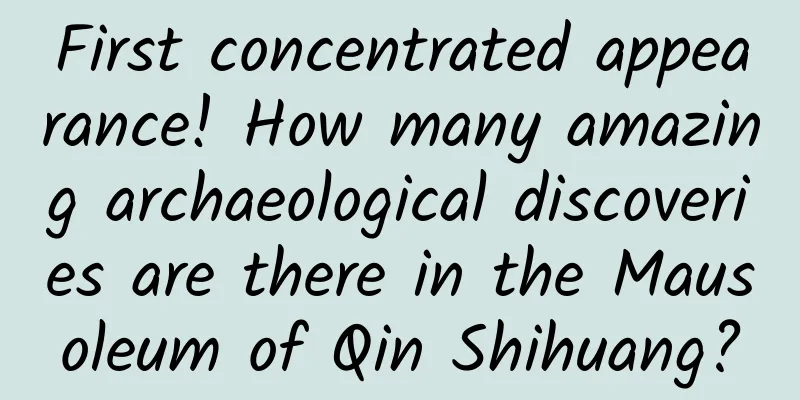First concentrated appearance! How many amazing archaeological discoveries are there in the Mausoleum of Qin Shihuang?

|
2024 marks the 50th anniversary of the archaeological excavation of the Terracotta Warriors and Horses of Qin Dynasty. In 1974, the discovery of the Terracotta Warriors and Horses of Qin Dynasty opened a new chapter in the systematic archaeological work of the Mausoleum of Qin Shihuang. Over the past half century, generations of archaeologists have continued to explore and pursue, allowing the majestic military formations and lifelike pottery figurines that have been sleeping underground for more than 2,000 years to see the light of day again, allowing the audience to appreciate the "Eighth Wonder of the World" while feeling the fruitful results of the archaeological excavation, protection research, and revitalization of the Mausoleum of Qin Shihuang and the Terracotta Warriors and Horses Pit. "The Terracotta Warriors and Horses of Qin are a wonder in the history of world cultural relics exhibitions and a 'golden business card' of China's cultural heritage diplomacy." At the recently held International Conference on the 50th Anniversary of the Archaeological Excavation of the Terracotta Warriors and Horses of Qin and the Protection and Research of the Qin Shihuang Mausoleum Site, Li Gang, director of the Qin Shihuang Mausoleum Museum, introduced that as of now, the Qin Shihuang Mausoleum Museum has received more than 160 million visitors from home and abroad, and has been successfully selected as a world-renowned cultural tourism destination, becoming a model for the protection, research and utilization of cultural heritage. Evidence of the development of Chinese civilization According to historical records, the construction of the Mausoleum of Qin Shihuang took 38 years and involved 700,000 people. The scale of the mausoleum and the richness of its burials are rare in the world. In March 1974, the Qin Terracotta Warriors and Horses Pit was discovered. On July 15 of the same year, the archaeological excavation of the Qin Terracotta Warriors and Horses officially began. In August 1975, the State Council decided to build a museum on the site of the Qin Terracotta Warriors and Horses Pit. On October 1, 1979, the museum was completed and opened. The main attractions include the Qin Terracotta Warriors and Horses Pit No. 1, 2, and 3, the Bronze Chariot and Horse Exhibition Hall, and related temporary exhibitions. On December 11, 1987, UNESCO listed the Mausoleum of the First Qin Emperor (including the Terracotta Warriors and Horses Pit) on the World Heritage List. As archaeological work continues to deepen, mausoleum buildings, underground palace structures, cemetery structures, and burial pits and tombs of various natures have "surfaced" one by one. Important "rare objects and treasures" such as bronze chariots and horses, painted kneeling archers, stone armor, and acrobatics figurines have appeared one after another. The outer storage, sacrifices, walls, gates, roads, projects and affiliated relics of the Mausoleum of Qin Shihuang have gradually become clear, providing a scientific basis for the comprehensive protection and systematic display of the Mausoleum of Qin Shihuang. Over the past decade, the continuous excavation of Pits 1 and 2 has continuously updated our understanding of the arrangement rules of the Terracotta Warriors and Horses. The excavation of Tomb No. 1 to the west of the Mausoleum, the first burial tomb of the empire under the regulations of the imperial mausoleum, has witnessed the transformation of the ancient Chinese central government from "blood politics" to "geopolitics". The exploration and excavation of the mausoleum gate site, city wall buildings, sleeping palace ruins, and road remains have provided new information for understanding important issues such as the funeral ritual process of the Mausoleum of the First Qin Emperor, the structural system of the ruins, and the spatial layout of the remains. Fifty years of archaeological work have clarified the overall layout of the Mausoleum of the First Qin Emperor, which is centered on the burial mound, with inner and outer cities and burial pits distributed around the burial mound, as well as the planning and design concept of simulating the capital city pattern, political system, court life, social culture, military system, etc. of the Qin Empire. The large number of unearthed relics and cultural relics of great value reflect the material culture, scientific and technological achievements and institutional civilization before and after the unification of Qin, and have played an important role in verifying the development of Chinese civilization and showing the brilliant achievements of Chinese civilization. From simple archaeology to national protection On September 8, the author saw the "On-site Emergency Protection Laboratory" of the Qin Terracotta Warriors and Horses Pit No. 1 and the "Archaeological Site Excavation and Protection Platform" of the Pit No. 2, which had just been officially put into use, in the Qin Shihuang Mausoleum Museum. "The Terracotta Warriors and Horses have been buried underground for many years, and the raw lacquer layer has deteriorated. At the moment of excavation, there is a risk of the raw lacquer layer falling off." Huina, deputy director of the Cultural Relics Protection Department of the Qin Shihuang Mausoleum Museum, introduced that after the establishment of the on-site emergency protection laboratory and the archaeological site excavation and protection platform, the temperature and humidity environment when the Terracotta Warriors and Horses were unearthed will be timely regulated, so that the painted pottery figurines, especially the painted lacquer base, can be more timely and comprehensively protected, and the smooth transition of cultural relics from the unearthed environment to the cultural relics warehouse storage environment will be achieved, and a new model of excavation of the Qin Terracotta Warriors and Horses will be explored and formed, namely, "on-site emergency protection system + archaeological platform system + special equipment + information support system". Over the past 50 years, through cross-field research, interdisciplinary research, and multi-team collaboration, the Qin Shihuang Mausoleum Museum has made the leap from simple archaeological excavations to a national-level cultural relic protection base for cultural relics protection and archaeological work. The talent team has also grown from a dozen excavation personnel to today's professional archaeological and cultural relic protection team with hundreds of members, successfully embarking on a new path of multidisciplinary and international cooperation in large-scale archaeological projects. In terms of legal protection, in July 2005, the Standing Committee of the Shaanxi Provincial People's Congress officially promulgated the "Shaanxi Qin Shihuang Mausoleum Protection Regulations", which provided a strong legal guarantee for the protection and management of the Qin Shihuang Mausoleum World Heritage Site; in July 2010, the Shaanxi Provincial Government promulgated the "Qin Shihuang Mausoleum Protection Plan", which further clarified the long-term development direction and construction blueprint for the protection and utilization of the Qin Shihuang Mausoleum; in 2021, the "Shaanxi Qin Shihuang Mausoleum Protection Regulations" were revised in light of actual conditions, making the protection of the Qin Mausoleum site more targeted and operational. The protection of the Qin Mausoleum site has steadily entered a scientific, standardized and legalized track. In terms of scientific and technological protection, since the 1990s, the Qin Shihuang Mausoleum Museum has actively carried out cultural relics protection and restoration cooperation with research institutions in Germany, Belgium and other countries, and has successively undertaken a number of national science and technology support plans in the fields of cultural relics protection and archaeology, and national "863" and "973" program projects, and successively built "Microbiology Laboratory", "Painted Cultural Relics Restoration and Protection Laboratory" and "Metal Cultural Relics Restoration Room", and gradually established advantageous scientific research fields such as protection and restoration of painted pottery cultural relics with Qin Terracotta Warriors and Horses painted protection technology as the core, scientific analysis and research of painted pigments, microbial prevention and control, and environmental monitoring and control. Comprehensive display of ancient and modern China The immersive digital experience project of the Qin Shihuang Mausoleum and the innovative transformation case of the archaeological results of the Terracotta Warriors and Horses Pit, which were released at the 50th Anniversary of the Archaeological Excavation of the Qin Terracotta Warriors and Horses and the International Conference on the Protection and Research of the Qin Shihuang Mausoleum, won rounds of applause from the audience with the wonderful performances based on the terracotta warriors and horses and combined with acrobatic art. For a long time, the Qin Shihuang Mausoleum Museum has been committed to planning high-quality original exhibitions, carrying out special educational activities, and developing high-quality cultural and creative products. Since the 1990s, a series of cultural and creative products represented by "Qin Terracotta Warriors" and "Bronze Chariots and Horses" have been presented as national gifts to visiting dignitaries. In recent years, through cross-border cooperation, thousands of cultural and creative products have been developed. The cultural performance products developed and created based on the Qin Terracotta Warriors are even more popular among tourists. Relying on the archaeological excavation and cultural relics protection results such as the Terracotta Warriors Pit, the Clerk Terracotta Warriors Pit, and the Bronze Chariot and Horse Pit, the Qin Shihuang Mausoleum Museum has promoted the development of digital virtual image technology, combined new technologies such as augmented reality technology with traditional methods such as display and site display, and built a platform for displaying the "dialogue" between history and the present. So far, it has won the National Museum Top Ten Exhibition Award three times. As a world-class cultural IP, the Qin Shihuang Mausoleum Museum has become an important venue for national foreign affairs activities over the past 50 years. So far, the Qin Mausoleum cultural relics have been exhibited in nearly 200 cities in 49 countries and regions for 277 times, and 20 million people have visited the exhibitions. The number of exhibitions and the number of visitors are second to none in the world. In order to exert the influence of the Qin Terracotta Warriors and Cultural Relics, the Qin Shihuang Mausoleum Museum has actively carried out international exchanges and cooperation, and has signed a series of cooperation agreements and memoranda with many countries such as Germany, Belgium, and the United Kingdom. The archaeological excavation of the Qin Mausoleum has been going on for more than half a century. The Qin Shihuang Mausoleum Museum has now developed into a comprehensive institution integrating archaeological excavation, cultural relics protection, scientific research, display, exchange and many other functions. It plays an important role in protecting, studying and utilizing the Terracotta Warriors and Horses cultural heritage and building a system for the inheritance of China's excellent traditional culture. It has made unique contributions to the comprehensive, three-dimensional and true presentation of ancient and modern China. |
>>: Who are the "superheroes" in the intestine? The "Justice League" of prebiotics and probiotics
Recommend
Quick Start on Precision Marketing for E-Commerce
Whether it is traditional offline business or onl...
4 strategies for building user operation systems!
What is the user operation system like? I believe...
Why does urine turn yellow when drinking less water?
Maybe everyone has noticed that sometimes when yo...
After Valentine's Day, it's Lantern Festival? Wrong! It's still Valentine's Day!
Mixed Health I don't understand the health tr...
Mobike and TikTok actually did this. What do you think of Ofo?
After ofo cooperated with the Minions to launch t...
How often should you replace your mobile phone? An experienced technician explains it very straightforwardly
The performance, appearance and advanced technolo...
A great job-hunting trick for programmers! A talented programmer writes his resume in C language
[[129819]] This is a resume that is also a readab...
5G base stations have been opened in six cities, which are 20 times faster than 4G!
China Telecom took the lead in announcing that it...
Video tutorial on techniques and methods for shooting short videos
Nowadays, many people find that as long as the sh...
Beware! The adulteration rate of such food for babies is as high as 70%!
The fish floss you feed your children may be a fa...
ARM confirms Huawei has the v9 architecture license, and the Kirin chip race against time has dawned
ARM has released Armv9, an architecture that clai...
Where to declare corporate income tax? Materials required for corporate income tax declaration
Corporate income tax is an income tax levied on t...
Douyin Promotion and Operation丨How to write a Douyin title that gets over 10,000 likes?
When it comes to new media, the first thing that ...
Is there a "sea" in the vast Gobi Desert? It is an "energy supply station" for migratory birds!
In Fuhai County in Altay Prefecture in northern X...
How to tap yourself on the shoulder on WeChat? What is the setup process for WeChat’s “Tap on the Shoulder” function? How to change the content of WeChat tap
How do I tap dad on the shoulder via WeChat? In f...









